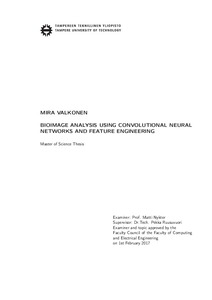Bioimage analysis using convolutional neural networks and feature engineering
Valkonen, Mira (2017)
Valkonen, Mira
2017
Sähkötekniikka
Tieto- ja sähkötekniikan tiedekunta - Faculty of Computing and Electrical Engineering
This publication is copyrighted. You may download, display and print it for Your own personal use. Commercial use is prohibited.
Hyväksymispäivämäärä
2017-06-07
Julkaisun pysyvä osoite on
https://urn.fi/URN:NBN:fi:tty-201705241453
https://urn.fi/URN:NBN:fi:tty-201705241453
Tiivistelmä
In digital pathology, analysis of histopathological images is mainly time-consuming manual labor and prone to subjectivity. Automated image analysis provides methods to analyse these images in a quantitative, objective, and efficient way. The aim of this thesis study was to implement an image analysis pipeline to analyse histological images and quantitatively characterise tissue histology. To achieve this, a feature extraction library was implemented that utilises feature engineering and convolutional neural network to extract quantitative characteristics from histological images. Machine learning with supervised learning was then applied to train multiple discriminative models based on the quantitative histological characteristics. The performance of the implemented system was evaluated in detection of breast cancer metastases in whole slide images (WSI) of lymph node sections. Three logistic regression models and a convolutional neural network were trained to separate metastatic tissue from normal tissue. Each model was able to detect the metastases with high accuracy (AUC = 0.89–0.97). The results show that the implemented image analysis system provides an accurate detection of hot-spot regions in WSIs. These image analysis tools can be directly integrated into a software that can reduce the workload of pathologists by providing tools for quantification of tissue histology.
